This is just one of over 100 articles in the author’s Astronomy Digest http://www.ianmorison.com
The mount on which ones telescope is attached is, in many ways, just as important as the telescope itself – and some say more important. If it is not sufficiently robust to support the weight of the telescope and its tripod is not sufficiently rigid the observing or imaging experience will not be good.
Often the mount comes as part of ‘package’ of mount and telescope and these are often either single arm alt/az mounts that are supplied with compact telescopes such as Maksutovs or Schmidt-Cassegrains or fork mounts that can be used either as an alt/az mount or, with an equatorial wedge, as an equatorial mount for larger Schmidt-Cassegrains. These do have some limitations as to the regions of sky that can be observed and so, particularly when buying a telescope tube assembly, be it a refractor, Newtonian or Catadioptric (such as Schmidt-Cassegrain) telescope, one will usually purchase either an equatorial or alt/az mount on which to mount it.
Alt/az mounts are more compact and easier to set up and are perfect for visual observing. When imaging, there is the problem of ‘frame rotation’ but, providing short exposures are used, the software such as Deep Sky Stacker or Sequator that aligns and stacks the individual short exposure frames to give the effect of one longer exposure compensates for this so it is not a major problem. On the other hand, equatorial mounts need first to be aligned onto the North Celestial Pole and then star aligned on one or two stars before use. An alt/az mount is thus perhaps better for use as a ‘get up and go’ mount to take out to dark sky sites.
In the past, equatorial mounts were almost universally used to track an object across the sky as only a steady drive rate in Right Ascension is required. In contrast, for an alt/az mount to track an object, continuously changing drive rates in both altitude and azimuth are required so needing a small computer for their control – now incorporated into the telescope’s handset. Near the zenith, the azimuth drive rate tends to infinity and so tracking can be a problem.
Simple manual alt/az mounts
Figure 1 shows the Sky-Watcher Az Pronto and AZ5 which are excellent examples of a simple alt/az mount ideal for taking out to dark sky locations with a small telescope. Vixen produce the PORTA II mount, shown in Figure 2 which is also highly reviewed.
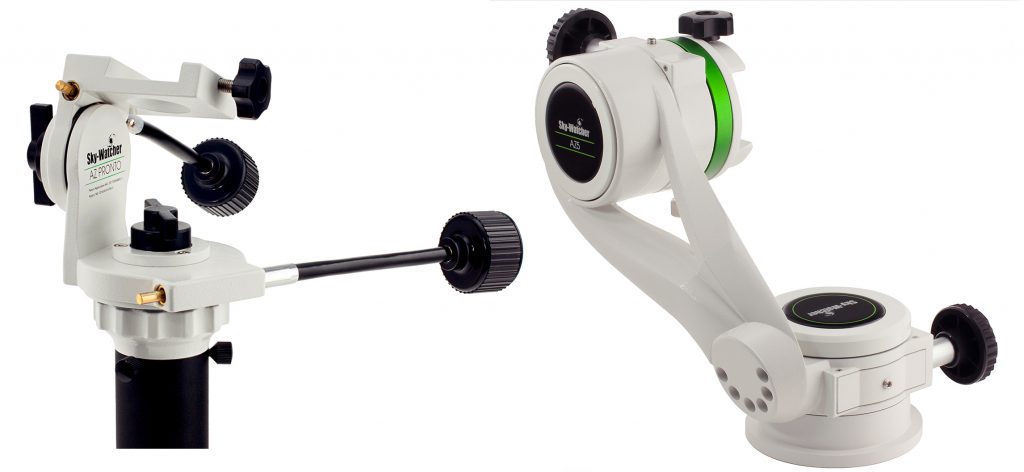
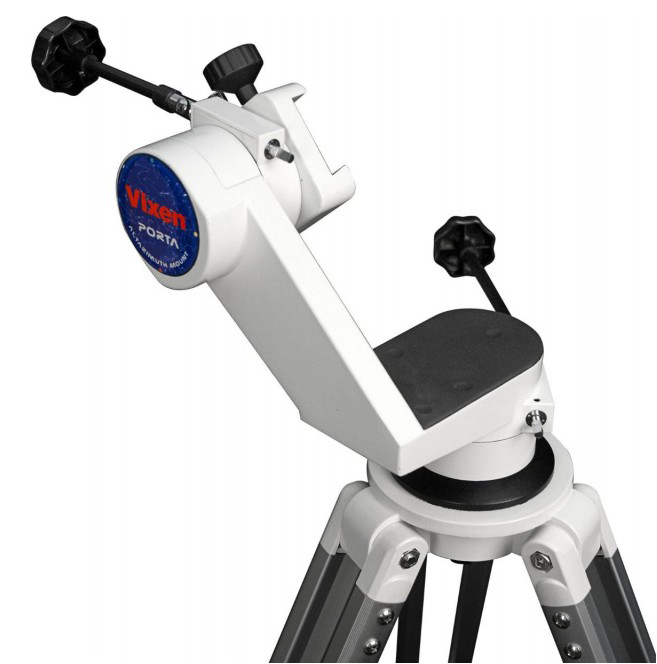
The Losmandy AZ8 Alt/Az mount
The impressive mount (Figure 4), costing £999, is constructed entirely of machined aluminium and stainless steel and can support two telescopes having weights up to 16 kg, such as a 127 mm refractor and a ~200 to 230 mm Schmidt-Cassegrain – so providing complementary views and making an excellent mount for use at star-parties! [Note that a counter weight would be needed if only a single telescope were to be mounted.] The total weight of the mount, riser and tripod is 12 kg with the riser included so that the azimuth variable slip clutch under the head can be adjusted. Large knurled knobs control the variable slip clutches for each motion so one can quickly move the telescopes to the desired object and then use the integrated slow motion controls to track the object across the sky using additional flex cables if desired. Losmandy provide an ‘Encoder Installation Kit’ for use with the AZ8 employing 311,396 step encoders giving a resolution of ~4 arc seconds. When used with a suitable controller such as the ‘Astro Devices Nexus DSC’, this gives the mount a ‘Push To’ capability.
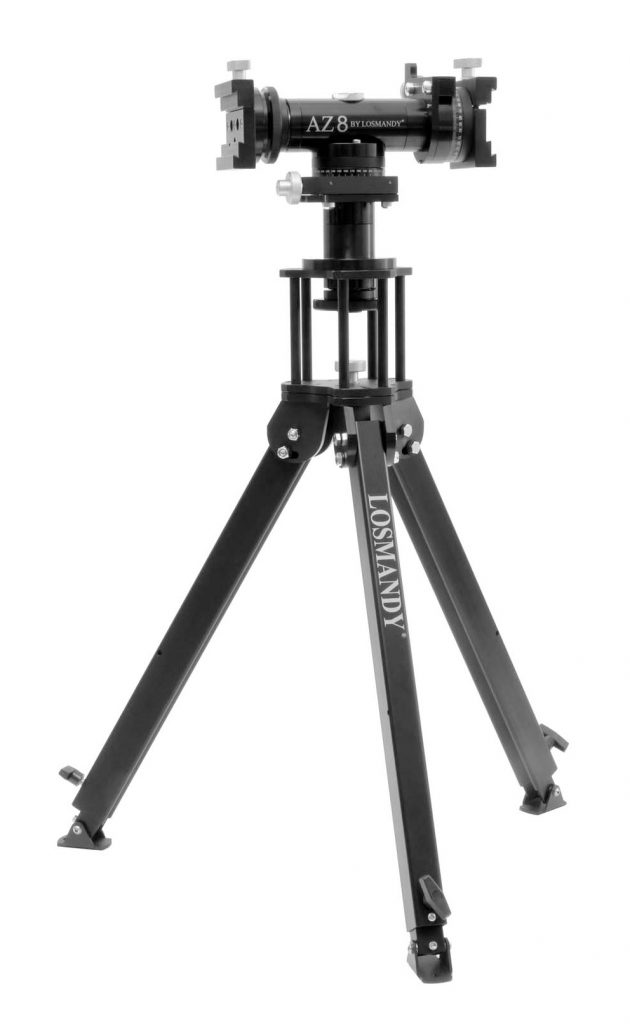
Computerised alt/az mounts
A number of manufacturers now produce computerised alt/az mounts varying in load capacity.
The iOptron SmartStar CubePro AZ Mount
Shown in Figure 4, iOptron at a cost of ~£300 produce a small computerised mount and tripod that can support a telescope of up to 8 lbs in weight. It can be powered by 8 internal AA batteries or an external 12 volt supply. The GoToNova controller has an 4 line LCD screen and an extensive object database. A GPS module provides the precise location, date and time so the mount is great for taking out to dark sky sites.
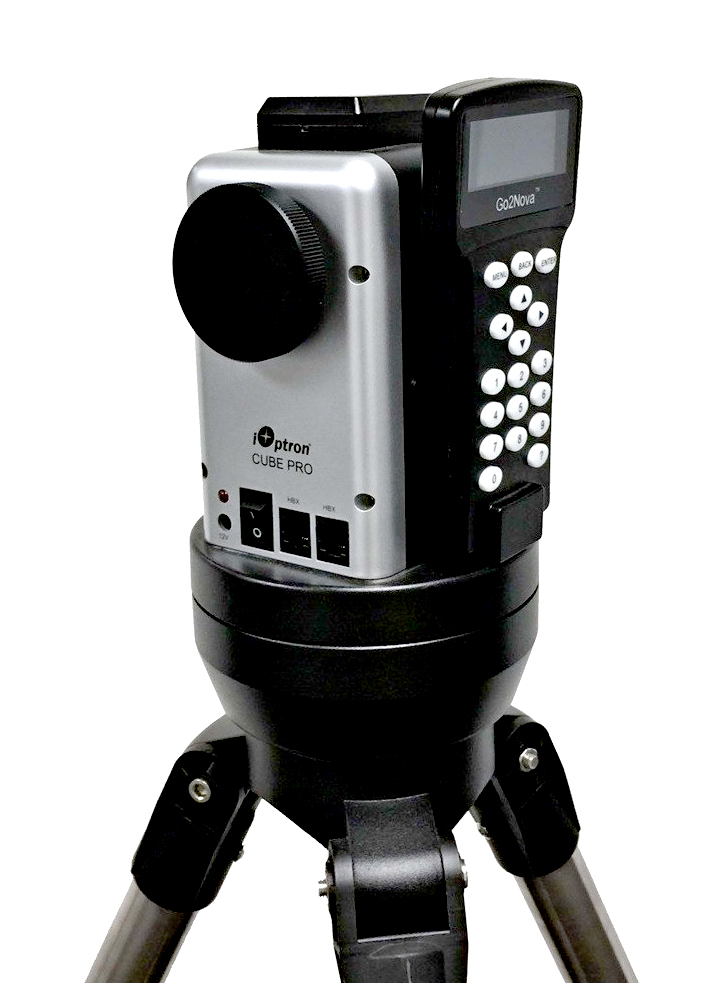
One first sets the tripod legs to set the mount horizontal using the incorporated spirit bubble level with the ‘south marker’ on the head pointed due south. The telescope is then mounted vertically, and one simply selects an object to observe. One may not know south’s precise direction (compasses in the UK now show true north and south to quite high accuracy) but this does not really matter. One can simply ‘goto’ a bright star or planet which may well, at first, not be in the field of view. Observing whether the object is to the left or right of the telescope pointing direction, a slow slew rate in azimuth will bring it into the field for, as the mount is accurately horizontal, the altitude will be correct so only an adjustment in azimuth is required. One then ‘synchronises to target’ and the mount will then find and track any other desired objects. Should this first object be a planet that one wishes to observe then the ‘alignment’ will have taken virtually no time.
The Sky-Watcher Allview Computerized mount
Costing ~£359, Sky-Watcher also provide a very cost effective alt/az mount that can carry a single telescope tube up to 9 lbs in weight. The Allview mount, shown in Figure 5, is either powered by 10 internal AA batteries or an external 12 volt source. Having set the time and nearest city (within 75 miles distance) into the handset, the mount is set horizontally and pointed to the brightest star that can be seen away from other bright stars. One is then asked to define the area of the sky in which it is located from 8 regions and the handset will then provide a list of bright stars in that region with their azimuth and elevation (a compass will be useful). Having selected and aligned on the appropriate star, the handset will display a list of other stars that can be used for the second star alignment after which one can observe objects selected from the nearly 43,000 objects within its database.
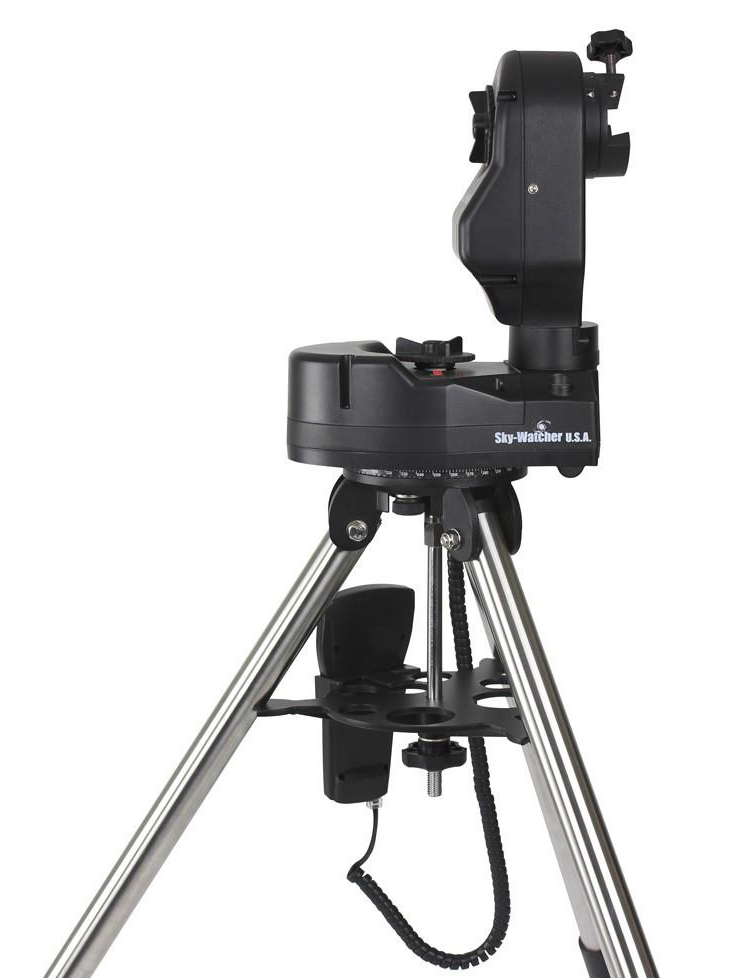
Meade LX65 Mount and tripod
Meade have recently introduced the LX65 Mount and Tripod (Figure 6) for ~£500 which has the ability to carry two telescope tubes, one on either side, having a combined weight of up to 21 lbs. The main saddle can hold up to 14 lbs, while the secondary saddle can hold up to 7 lbs. It can be powered from 8 internal AA batteries or an external 12v supply. To initiate alignment, the telescope is set horizontal and pointed North (a compass is included). Having set the location (country and nearest city) and time into the handset, the Audiostar handset will select two stars to align on and then observing can begin from the ~30,000 objects in its database. The Audiostar handset also provides descriptions of around 500 objects as they are observed.
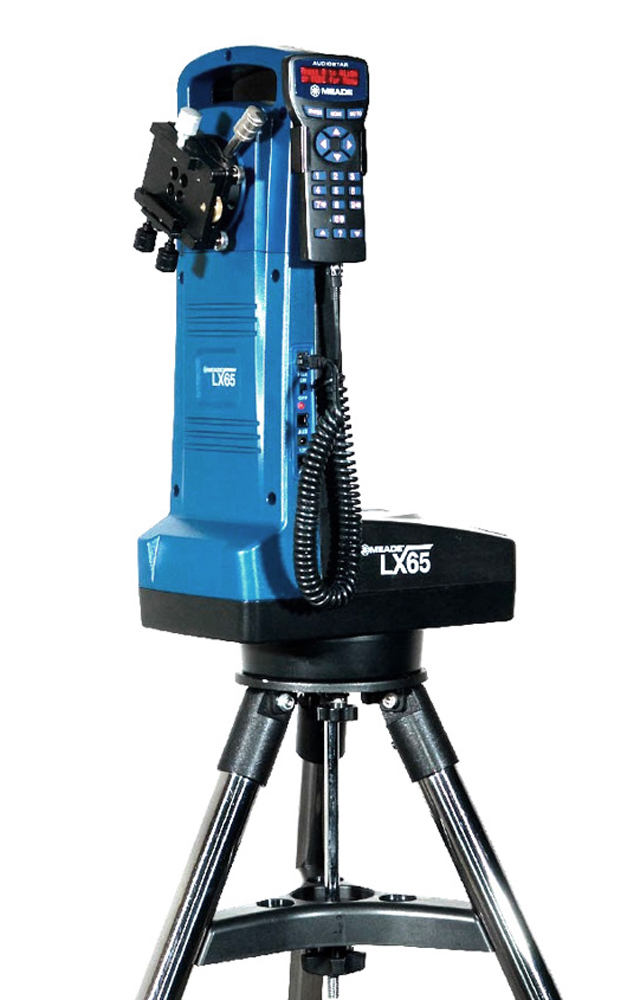
iOptron AZ Mount Pro Mount
As well as the ‘Cube’ mount described above, iOptron, at somewhat greater cost, have produced a series of MiniTower alt/az mounts that is now in the form of the iOptron AZ Mount Pro costing ~£1,069 including a 1.75 inch tripod and shown in Figure 7.
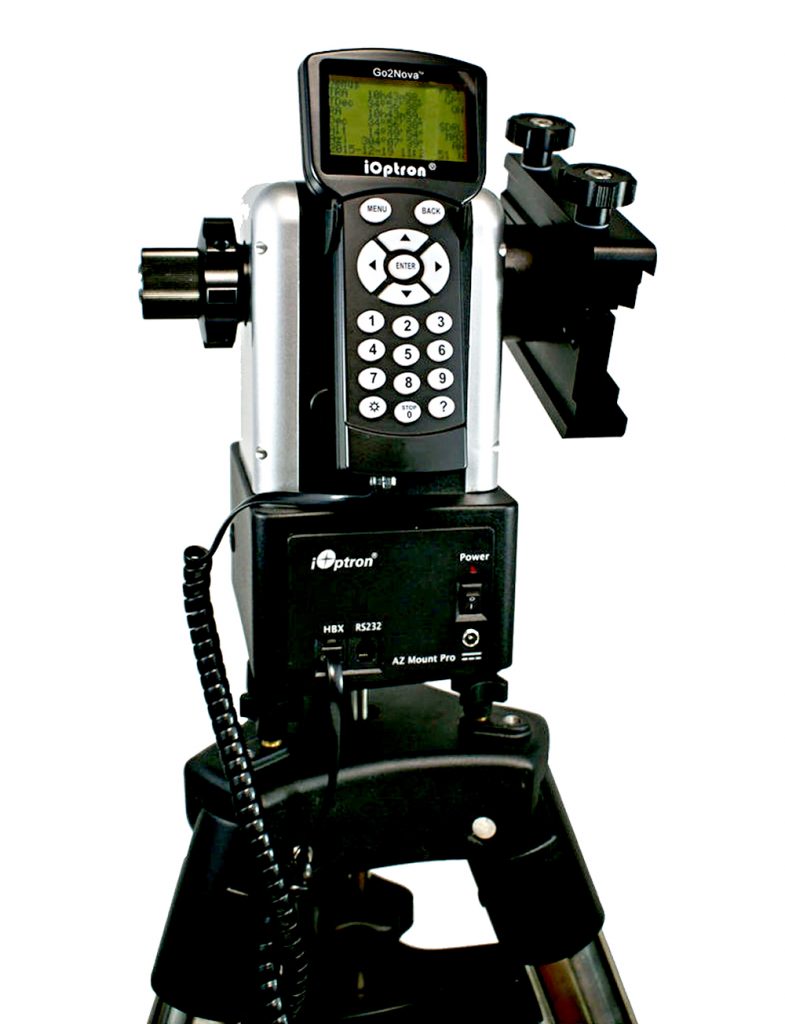
I reviewed the first MiniTower mount in the country for Astronomy Now magazine and was so impressed that I bought it and have used it extensively over the 10 years since then. The telescope is mounted on one side of the head with either a counterweight on the opposite side or, alternatively, a second telescope. This latter mode allows, for example, a small, wide field, refractor and 6 inch Schmidt-Cassegrain telescope to be mounted in parallel as seen in Figure 7. As with their Cube mount, it is equipped with a GPS module so, within a few minutes, has found the precise location, date and time. The head incorporates a rechargeable lithium ion battery for up to 10 hours use in the field and a WiFi adapter so that it can be controlled by, for example, the beautiful program, Sky-Safari. The ‘Go2Nova’ Hand Controller has an 8 line display and a database of over 200,000 objects! There is a more detailed review of the iOptron MiniTower mounts elsewhere in the digest.
